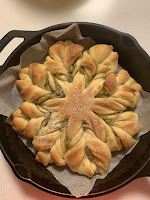Because I have no KitchenAid or any other gadget to help me through, I knead by hands. Kneading by hands allows you to feel the texture of the dough and adjust the ingredients as you go. Despite the hard work and the time it consumes, the satisfaction of bread making and the smiles that your family members wear after tasting it right out of the oven are priceless!
The secret of the softness of the Japanese milk bread is the Yudane/TangZhong/湯種. A portion of flour is cooked with water in a proportion of 1:5 in a pot until it turns to gel-like paste, it allows the gluten to gelatinize (more water is absorbed) and gives it longer and more elastic strands. The dough is very versatile, I use it for making burger buns, tuna mayo buns, sweet potato buns, cinnamon rolls, pizza pockets, pizza crust...etc. Also, be creative in shaping the dough! I am pretty happy with my star breads =)
+ + + + + + + + + + + + + + + + + + + + + + + + + +
The addition of honey and fresh cream give the bread extra level of tenderness and richness although I didn't exactly follow the recipe 100% (I reduced some of the ingredients).
Procedures:
- Mix flour, milk, sugar, yeast and salt
- Add tangzhong and knead well (initially it took me 1hr and now I am experienced, it takes 30mins!)
- Add oil and keep kneading
- Do windowpane test and ready for the first proof
- Let it sit for 1 hour or until 2x bigger in size (in cold weather, put it in the oven with a pot of hot water to facilitate the fermentation.)
- Remove the air bubbles
- Divide it into appropriate size and shape them, for milk bread: you can add any ingredients like ham, cheese...
- Allow second proof or until 2x bigger in size
- Preheat the oven at 180C and bake for 25mins









